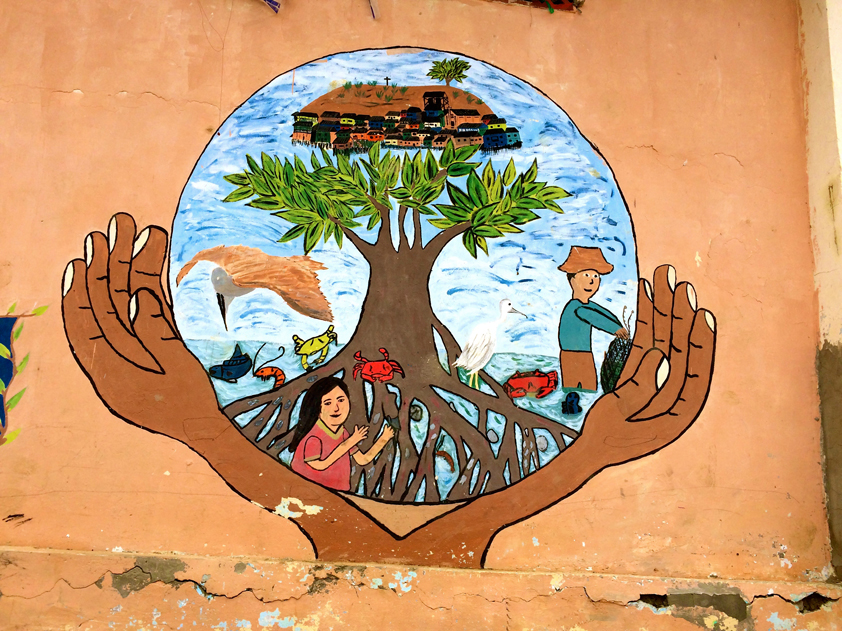Mass mangrove restoration: Driven by good intentions but offering limited results
There is an urgent need to address the global degradation of coastal ecosystems, but are mass mangrove planting initiatives sustainable?

Photo: Conservation International
In recent years, hundreds and sometimes thousands of volunteers have been involved in mass mangrove planting efforts, gaining media recognition and even earning entries into the Guinness Book of World Records. This has drawn attention to the urgent need to address the global degradation of coastal ecosystems. But are these planting initiatives sustainable? Do they have the desired impact? In short, do they work?
Coastal communities are first to face the impacts of coastal degradation – reduced flood protection, decreased water quality, extreme soil erosion and a rapid decline in the variety and abundance of food sources (many of which come from mangroves in the tropics). Mass mangrove plantings should help address these challenges in certain areas, but instead many restoration efforts worldwide (for example, in the Philippines) are failing.
What’s going wrong?
There are several issues. Restoring a mangrove is a complex process that needs to be founded on the principles of ecosystem management. Often, fast-paced and large-scale ‘restoration events’ are not necessarily scientifically robust in terms of which mangrove species should be restored, and where.
A common mistake in mangrove restoration is not choosing the right species for the right site. For example, mangroves are often planted in areas where they were not found previously, especially mudflats. Such sites are too exposed for saplings that cannot withstand soil erosion and wave action. Low oxygen availability due to constant moisture in mudflats results in high seedling mortality and stunted growth. This can be addressed by choosing local good quality seed for a suitable planting site.
Another element to consider is the ‘right mix’ of species – as some mangroves tolerate greater salt water flooding than others (an important consideration with sea level rise due to climate change). The diversity of species in an ecosystem influences its health, resilience and provision of ecosystem services. Restoration programmes that focus on planting a single species end up as a monocultures that have a low capacity for hosting biodiversity like fish and crabs and are vulnerable to pest aggregations. Those that do create a multi-species community need to combine species that complement one another. If these factors are not adequately considered, mangrove forests will not fulfil the ecological and physical functions for which they were planted, and will likely fail.
Another common error is not adequately involving the local communities in the process – beyond paid labour and photo opportunities. Adjacent rural communities often know much about successful mangrove management, and their involvement is key to long-term success in terms of restoration, management and benefit flows. In addition, their incentives are strong – communities gain benefits from successful mangrove restoration in terms of livelihoods and storm surge protection, among others. But they must have clear rights and responsibilities in the process.
What can we do about it?
Sustainable solutions to coastal degradation are available. For example, to solve the problem of exposed coastlines, Wetlands International’s Project ‘Building with Nature Indonesia’ in Central Java (featured on BBC News) is using a soft technique to break waves and trap sediments to promote the rehabilitation of the mangrove ecosystem (read up on advantages of mangroves in EbA in our last blog).
Conservation International’s Suriname Project ‘Building with Nature’ has witnessed great success following this technique. In fact, Wetlands International does not advocate for the planting of mangroves, but a restoration approach that facilitates their natural regrowth by creating ecologically suitable conditions. Questions on whether ‘To plant or not to plant’ are addressed in their guide.
Recognising the need for simple and accessible instructions for those keen to take action, The Mangrove Action Project (MAP) has produced a guide to ecological mangrove restoration (EMR) in 6 steps. MAP uses the Community Based Ecological Mangrove Restoration (CBEMR) approach, emphasising the importance of community participation. The Mangrove Restoration website holds 2000+ scientific articles concerning mangrove restoration – a resource not to be missed.
After planting, another important step in restoration involves monitoring and learning from what works or what does not work and why. Valuable publications to consider are a report on monitoring mangrove restoration from space and a manual on mangrove restoration for the Pacific Island Region.
With the increasing wealth and availability of knowledge on mangroves and how to restore them, successful restoration projects are possible. But they shouldn’t be driven by photo opportunities and media coverage. Instead, a sound, science-based plan that follows the principles of EMR/CBEMR, using trained personnel and community participation and ownership from the planning stage through to successful establishment, and community management and monitoring will lead to greater success.
****
Starting February 22, the World Ocean Summit 2017 discusses means to use capital and the private sector to drive scalable, sustainable investment in the ocean. IUCN along with its members and partners will be present to ensure mangrove restoration can also benefit from innovative financing solutions.
This article series on mangrove restoration is written by Juliet Blum and Dorothée Herr from IUCN's Global Marine and Polar Programme with the support of Germany's International Climate Initiative (IKI) through the IUCN Global Forest and Climate Change Programme.



